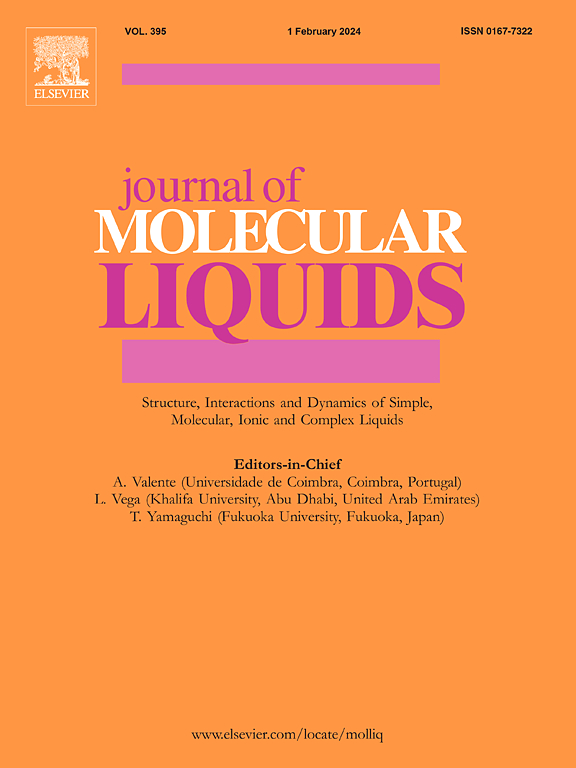氯胆碱-乙二醇捕集CO₂的实验优化与机器学习建模
IF 5.3
2区 化学
Q2 CHEMISTRY, PHYSICAL
引用次数: 0
摘要
深共晶溶剂正在成为可持续和环保的二氧化碳吸收替代品。本实验研究探讨了深层共晶溶剂对CO2的有效捕集。采用压降法对不同深度共晶溶剂配方的吸附性能进行了评价。利用响应面法确定并优化了CO2吸收的实验参数和最佳操作条件。溶解度研究是在受控条件下进行的,如深共晶溶剂摩尔比(范围从1:1到1:6),接触时间(从63到693分钟)和水的百分比(从17.5%到30%)。结果表明,在深度共晶溶剂摩尔比为1:4.75、接触时间为693 min、启动压力为15 bar时,CO2吸附效果最佳。为了进一步分析实验获得的物性数据,我们采用方差分析(ANOVA)来评估各影响因素的显著性。傅里叶变换红外光谱证实吸收后的DES中存在CO2。利用XGBOOST机器学习算法建立溶解度预测模型,成功预测了溶解度,最大误差为8.1%。这项研究强调了深层共晶溶剂有效捕获二氧化碳的潜力,并为进一步优化和应用提供了框架。本文章由计算机程序翻译,如有差异,请以英文原文为准。
Experimental optimization and machine learning modeling of CO₂ capture in choline chloride-ethylene glycol
Deep eutectic solvents are emerging as sustainable and environmentally friendly alternatives for carbon dioxide absorption. This experimental study investigated the efficient capture of CO2 using deep eutectic solvents. The pressure drop method was employed to evaluate the absorption capabilities of various deep eutectic solvent formulations. The response surface methodology was used to identify and optimize the experimental parameters and the best operational conditions for CO2 absorption. Solubility studies were conducted under controlled conditions, such as deep eutectic solvent mole ratios (ranging from 1:1 to 1:6), contact times (from 63 to 693 min), and water percentages (from 17.5 % to 30 %). The results indicated that the optimal CO2 absorption occurred at a deep eutectic solvent molar ratio of 1:4.75, a contact time of 693 min, and a starting pressure of 15 bar. To further analyze the physical property data obtained from our experiments, ANOVA was used to assess the significance of various influencing factors. Fourier transform infrared spectroscopy confirmed the presence of CO2 in the DES after absorption. The XGBOOST machine learning algorithm, which was employed to build the prediction model for solubility, successfully predicted the solubility with a maximum error of 8.1 %. This study highlights the potential of deep eutectic solvents for effective CO2 capture and provides a framework for further optimisation and application.
求助全文
通过发布文献求助,成功后即可免费获取论文全文。
去求助
来源期刊

Journal of Molecular Liquids
化学-物理:原子、分子和化学物理
CiteScore
10.30
自引率
16.70%
发文量
2597
审稿时长
78 days
期刊介绍:
The journal includes papers in the following areas:
– Simple organic liquids and mixtures
– Ionic liquids
– Surfactant solutions (including micelles and vesicles) and liquid interfaces
– Colloidal solutions and nanoparticles
– Thermotropic and lyotropic liquid crystals
– Ferrofluids
– Water, aqueous solutions and other hydrogen-bonded liquids
– Lubricants, polymer solutions and melts
– Molten metals and salts
– Phase transitions and critical phenomena in liquids and confined fluids
– Self assembly in complex liquids.– Biomolecules in solution
The emphasis is on the molecular (or microscopic) understanding of particular liquids or liquid systems, especially concerning structure, dynamics and intermolecular forces. The experimental techniques used may include:
– Conventional spectroscopy (mid-IR and far-IR, Raman, NMR, etc.)
– Non-linear optics and time resolved spectroscopy (psec, fsec, asec, ISRS, etc.)
– Light scattering (Rayleigh, Brillouin, PCS, etc.)
– Dielectric relaxation
– X-ray and neutron scattering and diffraction.
Experimental studies, computer simulations (MD or MC) and analytical theory will be considered for publication; papers just reporting experimental results that do not contribute to the understanding of the fundamentals of molecular and ionic liquids will not be accepted. Only papers of a non-routine nature and advancing the field will be considered for publication.
 求助内容:
求助内容: 应助结果提醒方式:
应助结果提醒方式:


